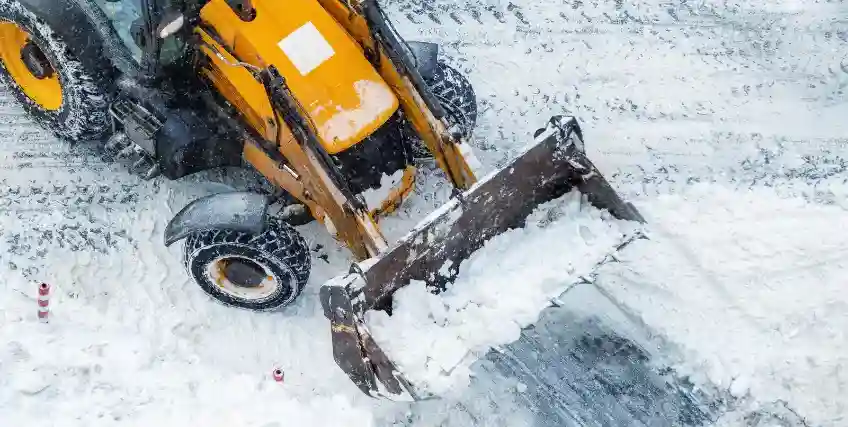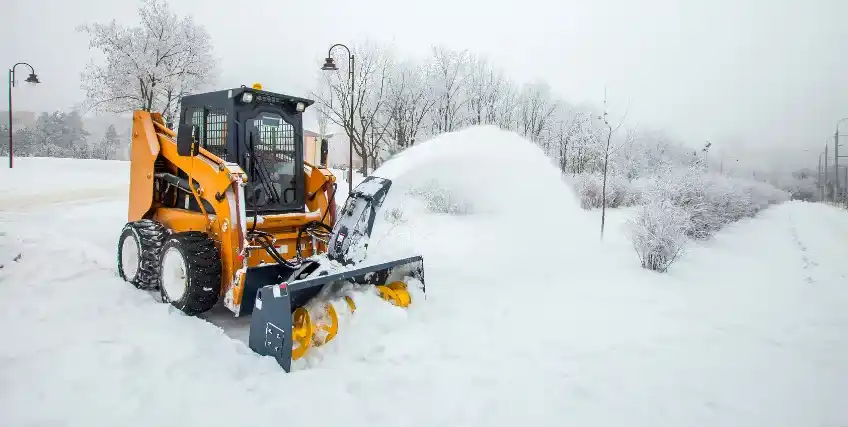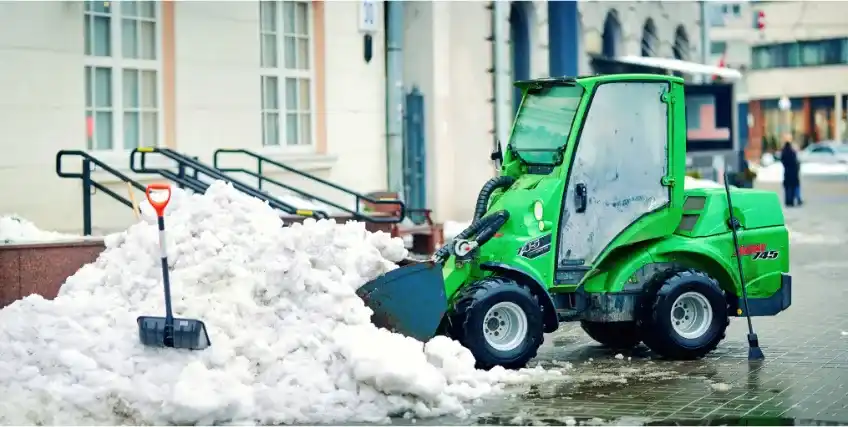Seasonal Guide: Preparing Your Snow Removal Equipment Before the First Storm
September 17, 2025 | Last Updated on: September 17, 2025

The first snowfall of the season often carries a sense of beauty and excitement, but for property owners, municipalities, and businesses, it also signals the start of a demanding responsibility: keeping spaces clear and safe.
For those managing properties, businesses, or entire communities, preparing for winter is not simply about convenience; it’s about accountability. Employees, customers, and residents expect safe passage, and failing to deliver could lead not just to frustration but to accidents, liability issues, or revenue losses.
This is why creating a seasonal preparation routine for snow removal machinery is an investment in peace of mind. In this guide, we will walk through why it is essential to get your snow removal equipment in top shape prior to the season’s first storm, highlight the benefits of preparation over reaction, and outline how readiness supports the broader scope of professional winter responsibilities.
Why Early Preparation Matters
Winter weather patterns are not always predictable. It may not appear until January in certain years and strike hard with large snows as early as November in others.
Anyone working in regions with unpredictable weather knows how critical timing is. Getting caught short for even one storm means lost productivity time, dangerous conditions, and added repair expenses that could have been avoided.
Assessing the Condition of Your Equipment
It is necessary to check the condition of your snow removal equipment so that you are prepared before the season of heavy duty meaning the heavy snow.
There are multiple types of snow removal equipment and utility vehicles, including single-stage snow blowers, sprayers, v-blade, v-plow, scraper, snow pusher, compact tractor, gas snow blower, and many more.
Mechanical health checks
The annual preparation saga begins with preliminary mechanical checks of snow removal equipment. Snow blowers, plows, and salt spreaders might sit idle for months during the off-season, usually in the storage or garage, where water, dust, or particles can induce corrosion.
Trying to use them in cold conditions for the first time often unearths buried mechanical problems. Working through oil levels, spark plugs, hydraulics, and belts before temperatures drop keeps you from being stuck repairing when you could be shoveling.
Consider this phase similar to a check-up for your health. Just as you wouldn't start a marathon without being aware that your body is prepared, you shouldn't venture into a snowstorm without ensuring your snow removal tools and gear are mechanically sound.
Small things such as oiling moving components or swapping out worn tires can make all the difference between smooth running and in-mid-storm failure.
Blade and auger readiness
An easily overlooked aspect of preparation is the cutting and clearing mechanisms themselves. In plows, blades should be inspected for dents, rust, or loose fittings that will decrease efficiency when battling compacted snow.
In snowblowers, auger blades should be inspected for wear and properly aligned to ensure even clearing. These adjustments may appear minor, but they determine not just how well your snow removal equipment performs, but how long it will keep doing it.
Stocking Up on Essential Supplies
Beyond gear maintenance is another area of preparation: stocking supply. A proper support material can be the difference between responding well and falling apart in the action. Shear pins, extra belts, hydraulic fluid, and fuel stabilizers are all seemingly trivial items until a catastrophic failure leaves your efforts suspended mid-cyclone. Prepurchase and storage of these items avoids costly delays when replacement parts are most difficult to procure.
Balancing Professional and DIY Approaches
Not everyone is able, or willing, to do their own snow removal. Single-family homeowners may manage with a single snowblower and a cheap spreader, but companies and municipalities typically require more sophisticated planning. That is where lines are drawn between do-it-yourself planning and professional contracting.
Other businesses opt for a commercial plowing service instead of investing a significant amount of capital in their own snow removal equipment. A retail complex manager, for example, may opt to contract out snow maintenance in order to maintain critical customer parking lots open. The responsibility of preparation falls in this instance to selecting a quality contractor up front, negotiating contracts, and ensuring their equipment is serviced.
On the other hand, larger commercial operations with control of fleets of blowers and plows must establish their own readiness plans. They not only maintain their snow removal equipment but also employ staff, keep salt spreader calibration and vehicle safety checks intact. Whether it is a do-it-yourself or professional strategy, advance planning is the formula for successful snow management.
Safety and Liability Considerations
The cost of snow clearing goes far beyond convenience. Neglecting to maintain snow removal equipment can lead to accidents and potential damage claims. Think of the danger involved when an inadequately serviced plow loses hydraulics while clearing a packed car lot or when a faulty blower sends debris instead of snow.
For businesses, especially winter services snow removal companies, safety isn't just a personal concern; it's economic and legal. Unplowed surface slips, trips, and falls are some of the most common winter liability claims.
Insurance premiums and lawsuits can skyrocket if safe, routine snow removal isn't followed. Putting your snow removal equipment in place ahead of the season ensures you're meeting safety guidelines, protecting public access, and staying out of trouble.
Extending Equipment Life Through Seasonal Care
Another compelling reason to prioritize seasonal preparation is the life of assets. Snowplow equipment is not cheap, especially for businesses using commercial-grade vehicles.
Not utilizing preventative maintenance yields higher breakdown rates, lower efficiency, and reduced overall life cycles for these cost-intensive machines.
Related Article: Snow Plow Financing, Tips to Qualify for Snow Plow Leasing: A Contractor’s Guide
Final Thoughts
The initial storm of the season is always the true test, but the secret to passing it without a hitch is preparation long before the weather forecast indicates snowfall. Whether you are a homeowner, a property manager, or a business operating commercially in snow removal, the preparedness of your snow removal machinery is not an option. Neglect produces emergencies, while preparation builds confidence.
Next season will present challenges, icy sidewalks, snowed-in driveways, and citywide storms, but with preparation and foresight, those challenges can be managed. The expense of money for early checks, gear, and caution is rewarded in efficiency and lowered stress.
As fall gives way to winter, the question is: will your snow removal gear be in position the first time a storm comes through, or will you reexperience old aggravations? Taking action now means that instead of scrambling, you're heading into the new season confidently.
FAQs About Snow Removal Equipment
Should I plow snow before rain?
If snowfall is light, there’s little benefit to using snow removal equipment before it ends, since it only adds extra work. For heavy snow, especially without two-stage snow blowers, clearing once or twice mid-storm makes the job easier.
Does it help to put salt down before a snow storm?
Pre-treating jobsites with salt creates a brine layer on pavement, reducing ice formation and making it easier for front mounted plows or other snow removal attachments to clear the snow. This method also allows for less salt use overall.
How much snow should there be before you plow?
When accumulation exceeds one inch, plan to plow. If snow sits too long, it can harden, making removal more difficult for snow removal equipment. Allowing snow to get too deep may even push some machines beyond their warranty recommendations.
Is passing a plow truck illegal?
In the U.S., passing a plow truck isn’t illegal but is risky. Front-mounted blades can throw snow and debris, reducing visibility and control. On single-lane roads, especially, staying behind the equipment is far safer for all drivers.
What skills do you need for snow removal?
Snow removal jobs require stamina, attention to safety, and knowledge of snow removal equipment. Familiarity with shovels, ice melt, snow removal attachments, and two-stage snow blowers is helpful. Most roles don’t require certification, though understanding warranty care is a plus.
Frequent searches leading to this page
Term Loans are made by Itria Ventures LLC or Cross River Bank, Member FDIC. This is not a deposit product. California residents: Itria Ventures LLC is licensed by the Department of Financial Protection and Innovation. Loans are made or arranged pursuant to California Financing Law License # 60DBO-35839




